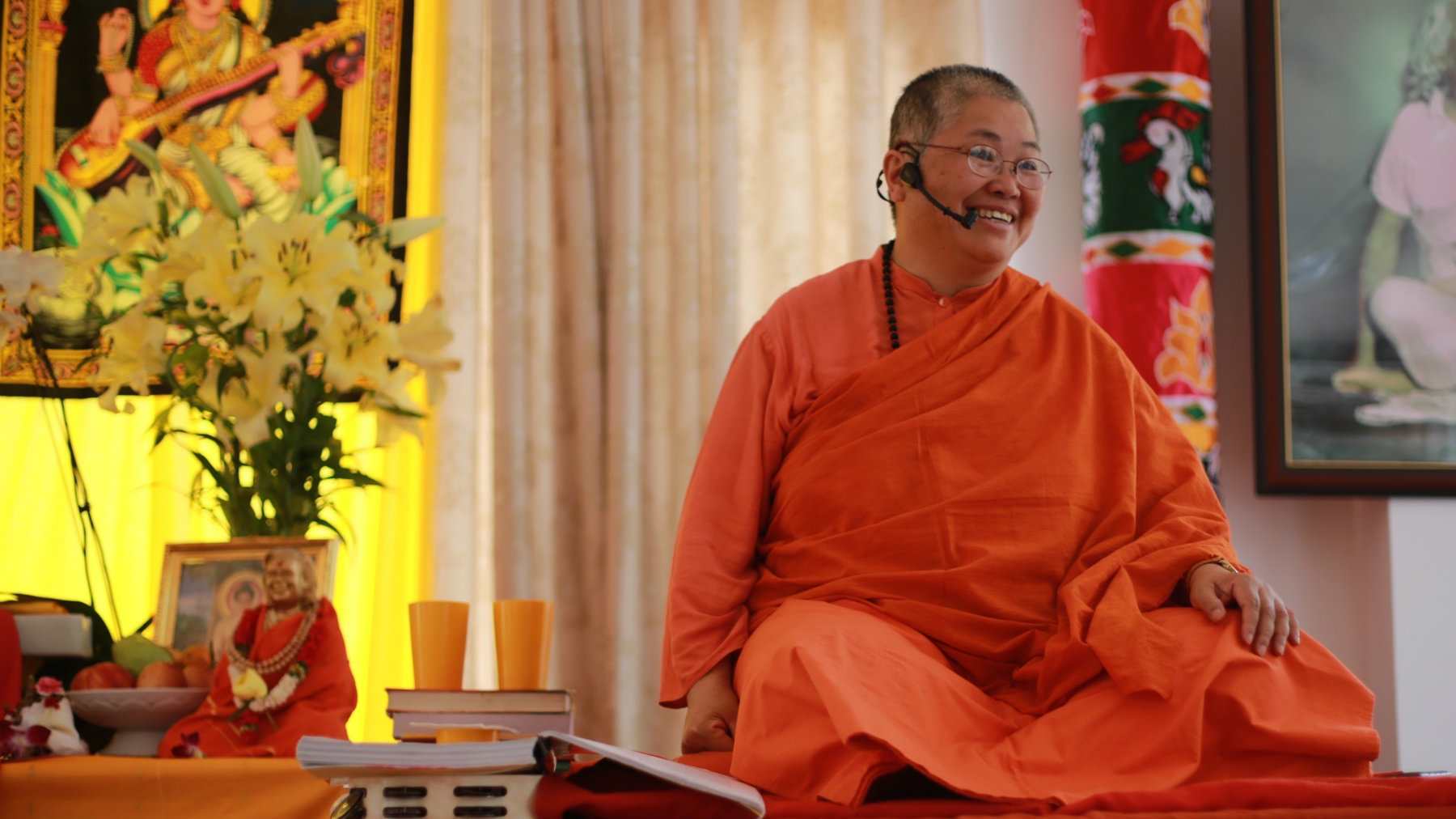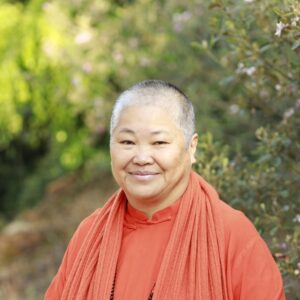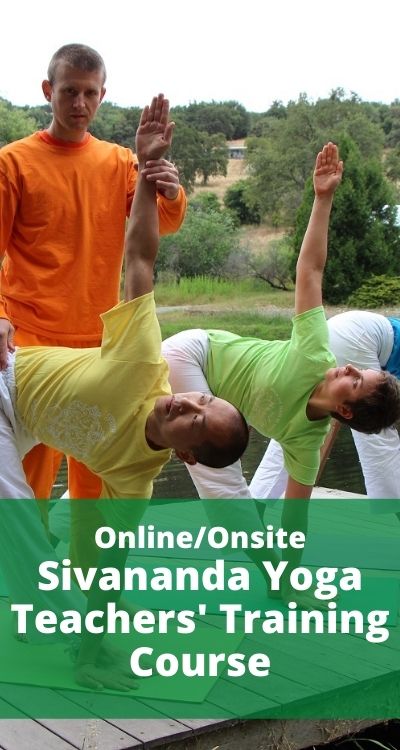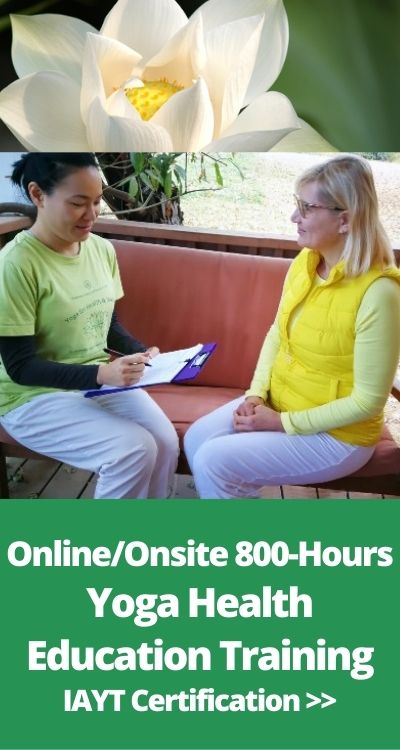
Yoga teachers as leaders
The important thing is that we unite together as Yoga teachers, Sivananda Yoga teachers. We have a mission to be leaders in this time of need. The aims and goals of the Sivananda Yoga Teacher Training Course is to create leaders who themselves have experienced the way to peace and in turn can show others the way to peace in times of crisis.
Yoga teachers as influencers, spreading positive thoughts
When the world is in panic and confusion, it is important to understand that crisis changes the vibration of the whole world. It is important that yoga teaching becomes known at this time, so people learn to turn their negative thoughts into positive thoughts and begin to understand the cumulative actions of their thoughts. This is what the Yoga teacher needs to know, that his or her thinking not only relates to him or herself or to the people in the same room or house with them, but thinking as a collective consciousness, our positive thinking affects the whole world.
Now more than ever we need to be aware of this, that our positive thoughts or positive words affect the world. We can help the world to heal by uplifting our consciousness through the conscious practice of Yoga sadhana. You may think you are alone in your house doing your practice and your voice does not count, but any thoughts that you broadcast during and after sadhana are very powerful. Moreover, as you practice Yoga and meditation now, you can switch your intention and do it for the sake of the world. This way, your practice not only improves your life but also improves the vibration of the whole world.
Yoga teachers are empathetic, sensitive, and realize the suffering of people in their communities. They feel what people are going through when everything in their life is collapsing or changing. We know that this is a moment of transition, a moment of choice for everyone. Yes, as Yoga teachers, we have a choice, either we are going to be depressed and spiral down or we are going to stay strong in satsanga and rise up, shifting our consciousness with the whole world.
Yoga teachers are like a lighthouse that radiate positive thoughts all around and influence the world’s collective thoughts, thus, playing a leading role in shifting the world’s consciousness.
Yoga teachers as powerhouses raising vibrations with mantra
The easiest way to increase your vibration is to repeat mantra. Sivananda Yoga teachers understand the healing effect of mantra, how it strengthens the mind, especially when chanted in a group. The energy is multiplied and touches the whole world to balance out the negative energy.
The best mantra for healing is Mahamrityunjaya Mantra. You can repeat this mantra daily or have it playing at low volume in your home or sacred space for someone that is sick or suffering:
Om Tryambakam Yajamahe Sugandhim Pushthivardhanam. Urvaarukamiva Bandhanaan Mrityormuksheeya Maamritaat
Play mantras for those who have just died or are on the sick bed. Repeat the mantra with your heart as consciousness (God) is dwelling in your own heart.
Yoga teachers as counselors
When the world is lost and afraid, it is important that Yoga teachers explain a few helpful points:
- The connection between Prana, Thought and Immunity
The higher the prana, the more we increase immunity to prevent disease. You need to explain this to your students and to your family, the link between prana and health.Prana is found in nature. By changing your lifestyle to connect to the prana in nature you improve your immunity. The best thing to prevent sickness is to increase immunity, the mechanism nature has given us to prevent diseases. Prana needs to be high. You increase the prana by absorbing the prana from nature.This is done by leading a proper lifestyle, by proper contact with the earth (eating the right food, contemplating trees, mountains, gardening, etc.); water (drink pure water, bathe in rivers, oceans); fire (being in the sun daily, eat warm food); air (breathing exercises in the clean air) and; ether (being in a positive thought atmosphere).
We need to learn how to conserve prana and not waste prana through negative thinking, useless worries and actions. We need to train and concentrate the mind and perform only mindful actions.
Too much information on the Internet that you cannot digest will cause you to lose prana. Gather only the information that you can digest. Like food, if you eat too much, you cannot digest what you eat, toxins will build up and the mind will be restless.
- Listening, comforting, being present
People need comfort, not merely calmness, but also a comforting presence and comforting words. The Yoga teacher’s presence is important. Now is the time to call your friends and relatives and to reach out to your neighbors to give them comforting words. It’s very easy to give comforting words, “How are you? We are concerned about you. Is everything okay? We love you.” Offer these comforting words with empathy.Empathy means we understand why you lost your job. We understand why you are home and don’t know what to do and you’re depressed, you’re worried. We understand. Empathy comes by listening. People need to be able to talk out their worry. Then you just listen without trying to give an answer, because really no one has the answer. Be humble and just try to listen, not just engaging people only when you feel that you have the answer. No one has the answer.Listen to what the person has to say, whatever they’re worried and concerned about. That’s enough to comfort them and to help them to calm down. It is a need to be listened to. - Relax by contemplating Nature
Being in nature helps us to relax. We don’t have to go anywhere. Actually, we can sit and just look at the trees and the water in the pond, look at the dog that is passing by. Just contemplating.By being still, learning how to contemplate, everyone experiences a state of calmness, and not just calmness, but a state of joy and unity. This is exactly what we mean when we talk about spiritual relaxation. There are a lot of techniques of Yoga that can bring you to that state. Yoga offers a wealth of information to apply for physical, mental and spiritual relaxation. The more you apply, the more you see that it works, and the more that it encourages you to practice. - Yoga for overcoming anxiety
There are many Yoga practices overcome fear and anxiety:
1) Breathing: The first point is to help people to improve the breath-body-mind awareness with rhythmical breathing. Just breathe with the diaphragm to get more oxygen, but also use rhythmical breathing to help calm the mind. When you practice asana, make sure to coordinate the breath with your movement and do pranayama.
2) Asanas for stress resilience: The second point is to increase prana by moving the body. If you feel that you are stuck or anxious, the flow of prana is blocked. When the flow of prana is blocked thoughts go down or repeat.You need to just keep moving, but consciously, by performing Yoga postures in the proper sequence to move the prana and to balance the flow of prana. Simply by moving the body in a balanced manner with awareness helps to balance the prana and increase stress resilience.
3) Improve mental-emotional balance: Mental and emotional balance is accomplished by regulating the breath. If you feel tension, you need to learn to exhale properly, calmly, and slowly to release tension. Let’s say you are talking to the neighbor and the neighbor is panicking, you can tell them, “OK, calm down now, just exhale slowly. Inhale and exhale to the count of six, or inhale and exhale to the count of ten.”
Go very slowly and they will calm down.Breath is connected to the mind. Awareness of the breath helps to concentrate the mind. People cannot practice Yoga when they are stressed. Why? Because their mind is obsessed with something external. At that time, you tell them to lie down, to stretch, to breathe, and to concentrate on the breath.
4) Learn to increase ojas shakti to avoid burn out: The fourth point is to understand that if we burn out our immunity goes down. One Ayurvedic teacher states that too much heat in the body leads to anger, too much thinking, and too much stress. So, you burn out your ojas. Ojas is the energy that sustains life.
The key is to increase ojas. Ojas shakti is the power of sustenance that brings contentment, gratitude and the sense of well-being. This is the subtle energy as taught by Ayurveda. Apply Ayurvedic principles in your diet and lifestyle to increase ojas shakti:
- Apply warm sesame oil to your body and head.
- Eat nutritious, simple food. The essence of the food will nourish you, feed the ojas and will help you to calm down.
- Take one or two teaspoons of ghee in your food and you will be nourished.
- Drink warm almond milk is also very good for increasing ojas.
- Cultivate faith and positive feeling in the Divine. Direct connection to the source of life will sustain you and increase your ojas shakti.
5) Increase the sense of safety: Create a sense of security, warmth, of quiet and support. The key is feeling safe. Let go of the worries and the defense mechanism. If you feel worried and fight-or-flight response is activated, your defense mechanism will wear you out.
It is paramount to relax, to activate your parasympathetic nervous system by Yoga asana in a conscious manner with rhythmical breathing along with faith.
6) Increase detachment: The sixth point is relaxation but going to a deeper level. It is about a change in attitude towards life. The prevalent attitude before was of being passionate about life, passionate about enjoyment of the senses. We call this a rajasic attitude, running here and there so that life gains meaning by experience and enjoyment.
We need to decrease these rajasic activities by increasing our detachment. This is a meditative, contemplative attitude towards life, stepping back to find the fullness within ourselves rather than attaching to what is “happening” outside.
- Self-Affirmation
Affirm your Self and repeat what you feel is positive and good. If you repeat a positive thought, that thought gains more momentum and more power in the psychic world and helps you in due time. For example, write down this sentence and repeat it many times, “I am content and happy with my Self,” or “Day by day, everything is improving, everything is better in every way,” or “I am content and with the present moment”.When you feel anxious, this affirming thought will rise to the surface of the mind to help you. Self-affirmation needs to be done daily until it becomes a positive habit. Another practice is to create a daily gratitude list and use what we are grateful for as affirmations. - Faith increases immunity
In times of crisis, people tend to doubt, to be fearful, and to lose faith. You have an inherent connection with Mother Nature, the mother Goddess, the universal presence within your own body that is always with you and in your surroundings. Swami Sivananda reminds us to follow the laws of nature and to live in harmony with nature. Having this deep connection with our own true nature dispels fear and restores faith. - Vedanta philosophy about the Self and the not-Self
The Self, the immortal Atman, is ever-present, untouched, blissful. It is the consciousness underlying all things. Remember the Atman and detach from all that is transient and changing. Use your higher faculty to discriminate, to know the difference between what is permanent and that which changes; what is the Self and that which is the not-Self.Remember that there is a presence within you, a consciousness within you, no matter what. Find safety and comfort in that presence as your own inner reality. Tune to that divinity that we see outside as the all-present, nourishing and caring Mother Nature.
 Swami Sitaramananda is a senior acharya of the International Sivananda Yoga Vedanta Centers (ISYVC) and is director of the Sivananda Ashram Yoga Farm in Grass Valley, California and the Sivananda Yoga Resort and Training Center in Dalat, Vietnam as well as more city centers in Ho Chi Minh, Dalat, Hanoi, and Tokyo, Japan. Swamiji is the acharya for Asia as well as the organizer and teacher of the Sivananda Yoga Health Educator Training (SYHET) program, an 800-hour program on yoga therapy, accredited by the International Association of Yoga Therapists (IAYT).
Swami Sitaramananda is a senior acharya of the International Sivananda Yoga Vedanta Centers (ISYVC) and is director of the Sivananda Ashram Yoga Farm in Grass Valley, California and the Sivananda Yoga Resort and Training Center in Dalat, Vietnam as well as more city centers in Ho Chi Minh, Dalat, Hanoi, and Tokyo, Japan. Swamiji is the acharya for Asia as well as the organizer and teacher of the Sivananda Yoga Health Educator Training (SYHET) program, an 800-hour program on yoga therapy, accredited by the International Association of Yoga Therapists (IAYT).


